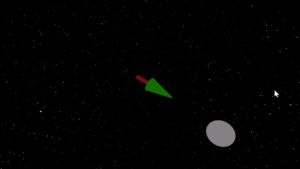Smooth rotation
Problem
You want to smoothly rotate a 3D object to point in a new direction.
Solution
When you first encounter this problem, you may find yourself thinking in terms of Euler angles - the three values representing the angles to the x/y/z axes. While Godot will allow you to see the object’s Euler angles in the rotation property, it is not recommended to use them to work in 3D. There are a number of reasons why this the case, such as a problem called “gimbal lock”, where you lose one degree of freedom when one of your rotations reaches 90 degrees.
If you’re interested in the background behind Euler angles and the problems they introduce, like gimbal lock, here’s a video that explains it well.
We can avoid using 3D Euler angles in Godot by using the object’s transform property. This property represents the body’s position and orientation in space. It uses a mathematical construct called a matrix to do this, but you don’t really need to understand the underlying math in order to make use of it.
look_at()
Let’s say you have a 3D object such as a missile or arrow and you want it to point at its target. You can do this using the Node3D method look_at():
func _process(delta):
var target_position = $Target.transform.origin
$Arrow.look_at(target_position, Vector3.UP)
This code would make our node ($Arrow) always point at the target’s position, no matter how it moves.
Note that look_at() requires 2 parameters: the target position, and an “up vector”. Imagine an airplane pointing its nose towards a target - there are an infinite number of ways it could be oriented, because the plane could roll about its axis. This second parameter is how you define what you want the final orientation to be.
Smooth rotation
The above code works, but it snaps the rotation instantly to the target. This might be fine if you have a very slow-moving target, but looks unnatural. It would look better if we move smoothly, or “interpolated”, the rotation smoothly between the starting orientation and the ending.
Godot has us covered here too. Rather than look_at(), we can use the Transform object’s looking_at() method, which doesn’t rotate the node, but returns the transform that would be looking at the target. Combine this with the interpolate_with() method, which returns an intermediate transform between a current one and a target one, and we can smoothly transition between the current orientation and our desired one.
var speed = 5
func _process(delta):
var target_position = $Target.transform.origin
var new_transform = $Arrow.transform.looking_at(target_position, Vector3.UP)
$Arrow.transform = $Arrow.transform.interpolate_with(new_transform, speed * delta)
Note that since interpolate_with() operates on the transform, it can be used to interpolate both rotation and position of an object.
Wrapping up
That’s it! Use this handy method to rotate your 3D objects, and stop thinking about angles!

